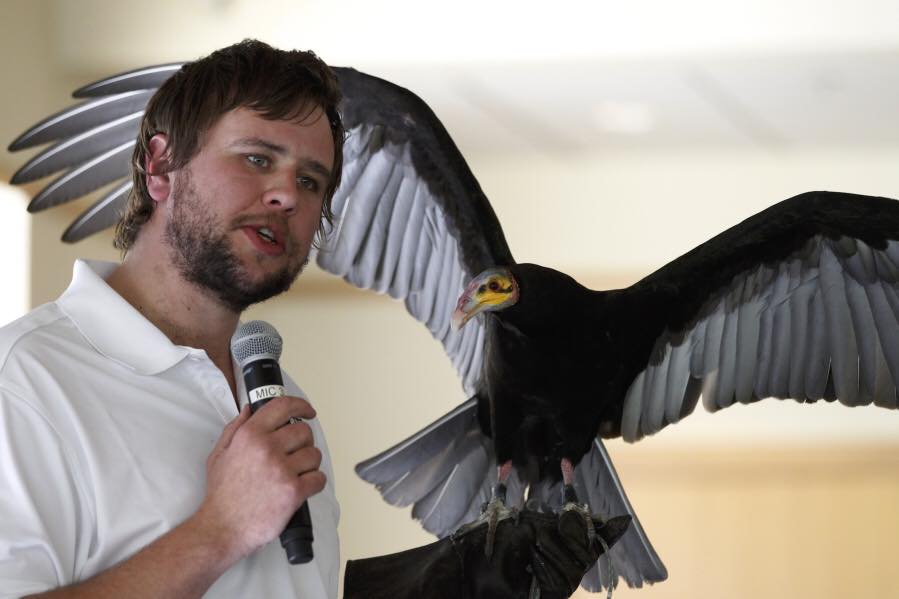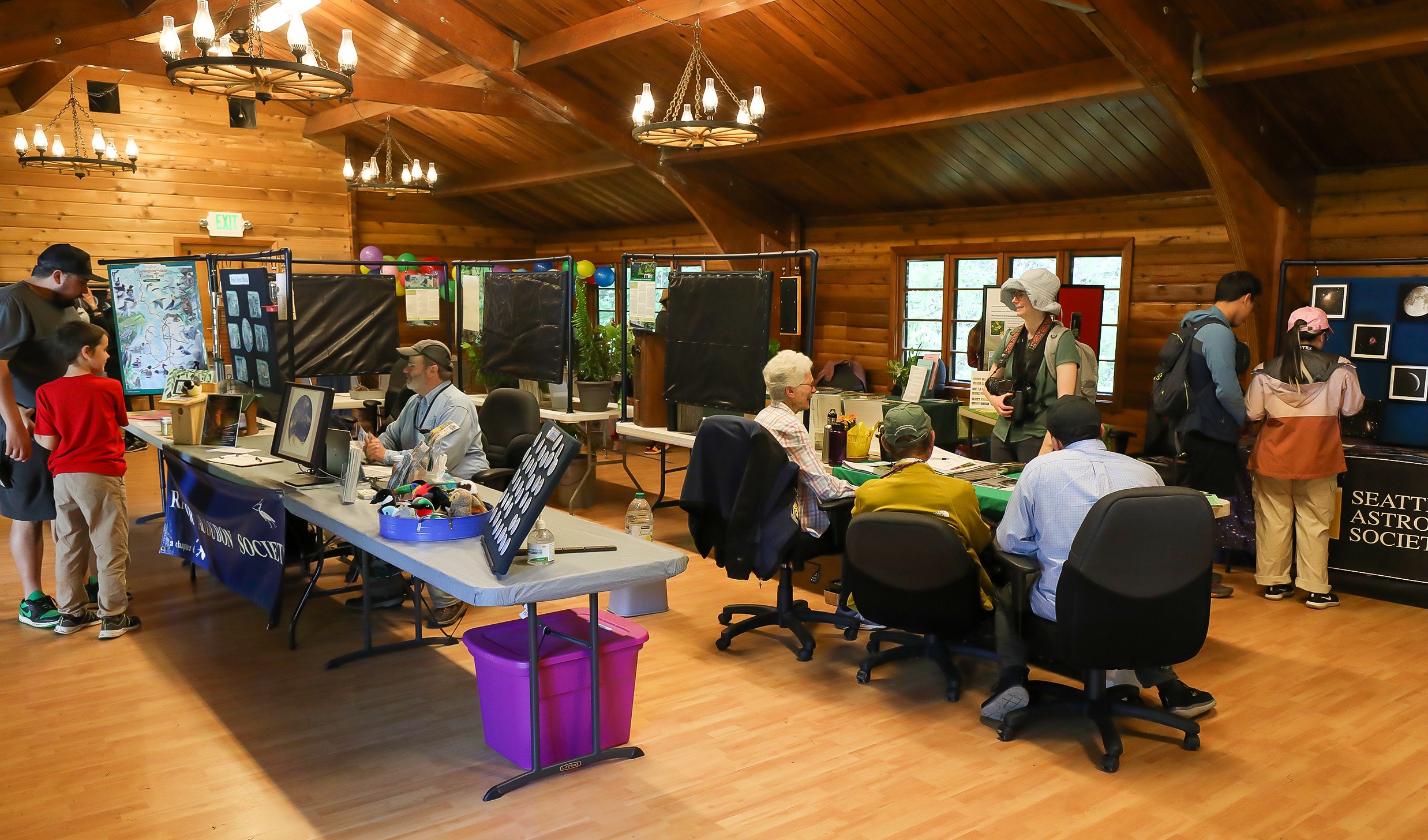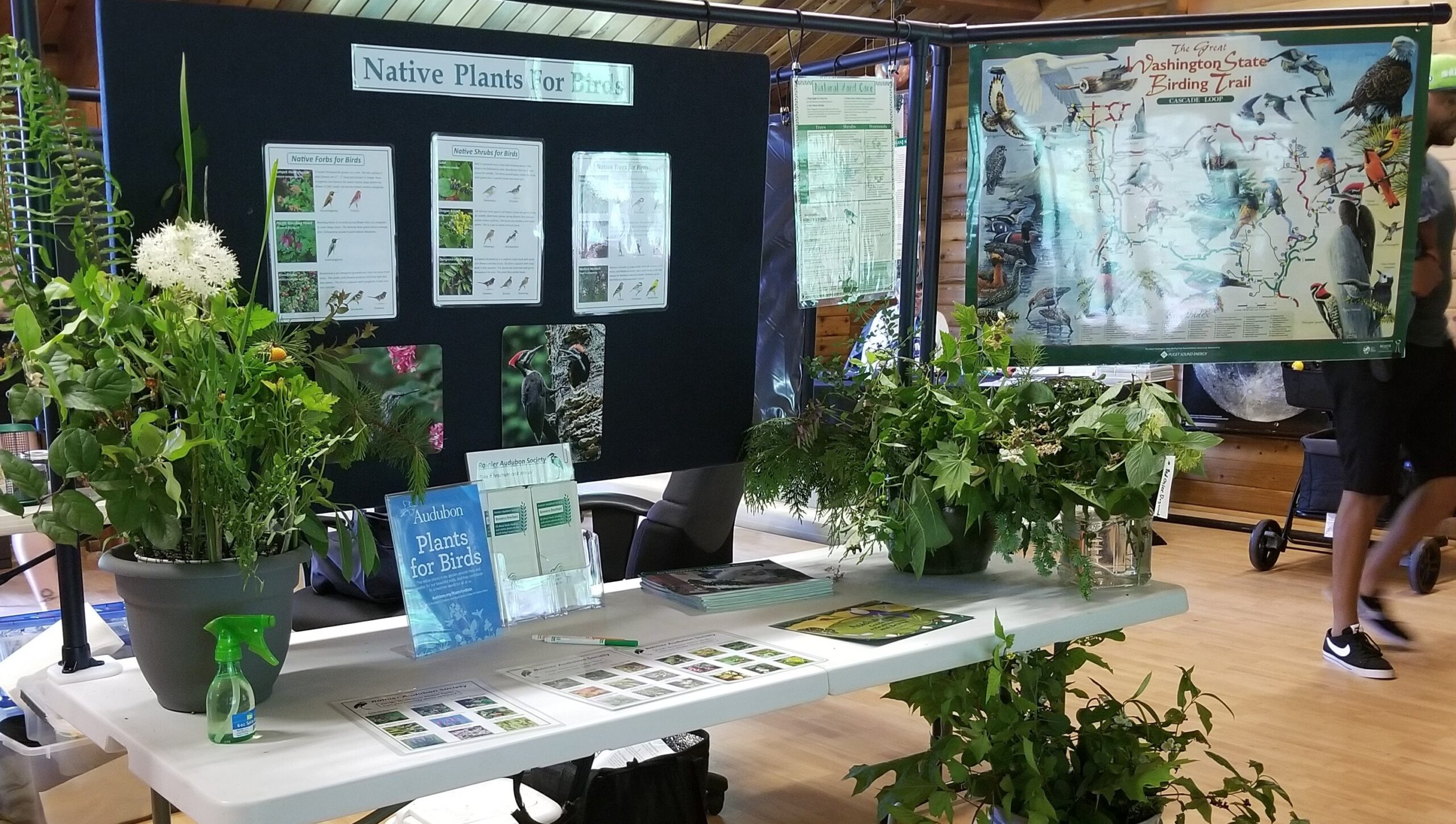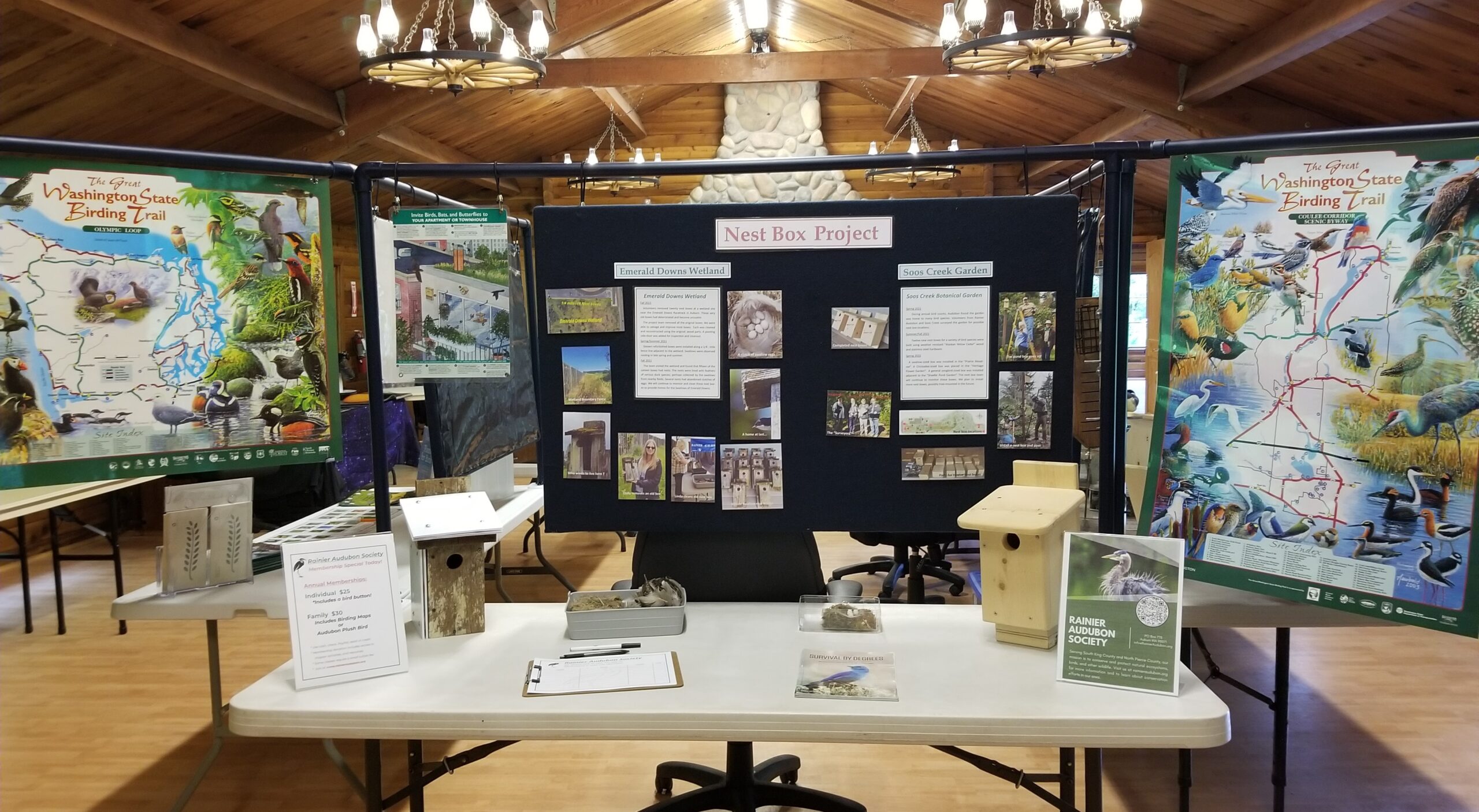
Seen & Heard: January 2022
By Calen Randall
2021 may have been the Year of the Ox, but in the Pacific Northwest, it was the year of the finch. Pine Siskins were notably abundant, particularly to start 2021. We had our fifth highest siskin count on the Kent Auburn CBC and for several weeks, it seemed like every flock of birds zipping overhead was a cloud of chattering siskins. Through the spring, finch frenzy continued, with large flocks of Evening Grosbeaks migrating through the Puget Sound region, though not in nearly the irruptive irregularity as the siskins. In late 2021, another finch species captured attention, as Common Redpoll were sighted picking at the catkins around Green Lake and other areas of north Seattle and Redmond. Common Redpoll last had a major irruptive winter in the area in 2018. However, there’s one finch species population that is soon to be a south Puget Sound mainstay. It is neither the boom-or-bust Pine Siskin, nor the irruptive rarity Common Redpoll, but none other than the cousin of our state bird, the Lesser Goldfinch!
Several of our Rainier Audubon members have had the good fortune of Lessers visiting their yard in past years. Back in April 2016, a female Lesser Goldfinch visited Marie West-Johnson’s yard in Renton. In January 2019, a pair of goldfinch visited Garrett Haynes’s Auburn yard for a week. For several years, I have wondered, “When will the first Lesser Goldfinch visit my yard?” Late in November, as I sat down to lunch, a flurry of yellow on my neighbor’s feeder caught my eye. At first, I passed it off as our resident Townsend’s Warbler, who enjoys snacking on the suet during lunch hours. However, this Townsend’s sported a bright lemon-coloured belly with black wings, back, and head, as though it had on a black jacket and cap. Out popped another, slightly less dressed up yellow bird. These were no Townsend’s Warblers, Lesser Goldfinch had finally visited my yard! Since late November, the Lessers have continuously returned, typically in the later morning, and increased in numbers. As many as nine Lessers will crowd
onto the feeder. Recently, I spotted a trio of them taking a dip in the water feature. Several have also flown to the ground, snatching at the garden grasses and picking at the seeds, like Pine Siskins pouncing upon and picking at dandelions. I love to stand in the backyard and listen to their vigorous chatter.



Pictured: A male and female Lesser Goldfinch pair visited my neighbor’s feeder this November and December
Goldfinch are worth keeping an eye on as they gradually expand their range northward. In the past decade, the Portland Metro Area has seen an explosion in Lesser Goldfinches (visualized below). Despite the major increase in Portland’s Lesser population, up until five years ago, Lessers were still a rarity in the Puget Sound. Around 2013, Pierce County birders were wowed as several pairs of nesting Lessers were discovered at the Riverside County Park along the Puyallup River in Sumner. Over the next few years, the goldfinch began strengthening their presence throughout the upper Puyallup River Valley. Large flocks of up to 40 were sighted at Riverside and sightings of Lessers in Orting became increasingly frequent. Today, you can find Lesser Goldfinch consistently in Sumner and Orting as well as occasionally in Puyallup, Enumclaw, and the Snoqualmie Valley.


Pictured: Lesser Goldfinch eBird sightings in Portland before 2011 (Left) and after (Right)
Given the habitat of the region, it is not surprising that Lesser Goldfinch have settled in the south Puget Sound valleys. Lesser Goldfinch favour wooded clearings and brushy open space like agricultural regions. They make use of the available farmland and surrounding mixed forest neighborhoods. Cottonwood forests along riparian zones are the preferred nesting grounds for Lesser Goldfinch. Cottonwood groves like those along the White and Green River in Kent and Auburn could be prime Lesser Goldfinch nesting habitat in the coming decade. Based on their climate change projections, National Audubon anticipates that Lesser Goldfinch will expand their year-round range into coastal and interior British Columbia over the next several decades. Check out Lesser Goldfinch | Audubon Field Guide to explore how a changing climate and shifting habitats are expected to impact the Lesser Goldfinch range over the century.
Though Lesser Goldfinch are slowly expanding into our region, never in the 41 years of the Kent Auburn Christmas Bird Count has a Lesser Goldfinch been recorded. Will this finally be the year that we finally get a Lesser Goldfinch on the count? Tune in next month for the CBC special report. Send your sightings and interesting bird stories to me at calenbirds@hotmail.com!
Hotspot of the Month
Interurban Trail, Fife-Milton Corridor, Pierce, WA—Chances are, if you’ve ridden a bike in the area, you’re familiar with the Interurban Trail running from Tukwila to Pacific. However, did you know that there is an unconnected section of the Interurban Trail in Fife and Milton? Not only is this hidden section of the Interurban a pretty walk or a short bike ride, it is also an interesting birding hotspot. The trail wraps around a wide field in Fife before entering forest and following the Hylebos Creek ravine up the hill into Milton. With binoculars you might pick out an American Pipit or a Wilson’s Snipe skulking in the muddy fields. Listen carefully for the call of a Lincoln’s Sparrow. Dozens of waterfowl splash about in the flooded ponds. Last spring I spotted a Cinnamon Teal feeding in the ponds on its journey north! Shorebird surprises like Solitary Sandpipers have visited the fields too. The forested trail is lively. In the fall and winter, mixed flocks of Bushtits and Ruby-crowned Kinglets zip across the path. In the spring, the leafy maple canopy is filled with the calls of nestbuilding warblers and flycatchers. Even if the trail isn’t birdy, it is certainly pretty and easy to see the progression of the seasons. Plenty of maples, alders, and cottonwoods yield a variety of gold, crimson, and orange leaves in the fall and lush green in the spring.
Want to visit the Fife-Milton Interurban Trail? A new lot with plenty of parking space was recently constructed at the south end of the trail on 20th Street East in Fife. The 2.5 mile long trail also has a trailhead on 380th Street in Milton, but there is much less parking space available. eBird hotspot link: Fife–Bath Rd. Interurban trail, Pierce County, WA, US – eBird Hotspot
Recent Sightings
November 6th, 2021—This fall, one surprising goose species paid a visit to the Puget Sound, an Emperor Goose! This waterfowl species rarely ventures out of Alaska, but when it does, it journeys quite far. In the case of this Emperor Goose, it journeyed all the way to Puyallup. Ironically, the goose had stopped to feed in the fields just outside Watson’s, a local nursery. If geese are your favorites, this field was the place to be. Over 2,000 Cackling Geese were picking through the pumpkin field, squawking away. A quintet of Greater White-fronted Geese stood standoffishly at the edge of the flock of Cacklers. Usually I don’t think of Greater White-fronts as being large, but they towered over their petite Cackling cousins. The shuffling of a couple other white geese caught my attention. Not even 100 feet away was the Emperor Goose, flanked by an immature Snow Goose! It was fun to observe the Emperor Goose as it picked through the field. Its scale-like cross-hatched texture of its feathers was especially unique. The Emperor and Snow Goose were truly best of friends and the Emperor was always following the Snow’s lead. When the Snow Goose lay down and rested, the Emperor would lie down and rest. When the Snow Goose stretched its wing, the Emperor would follow the pose. The next day, the large flock of Cackling Geese remained, but the pair had left for new pastures. Interestingly, it’s possible that this Emperor Goose had been on a West Coast tour. On October 8th, an immature Emperor Goose was spotted north of Chico, CA. According to some reports, it seemed to favor the company of a Greater White-front. A couple weeks later, an Emperor Goose visited Portland, OR and a few days later an Emperor was seen up the Columbia River at Hermiston, OR. Not long after an Emperor Goose was first sighted in Fife. Could this be the same Emperor Goose on an incredible journey?
December 2nd, 2021—December kicked off with a seabird extravaganza in the Puget Sound thanks to a blustery cold front. A strong westerly wind developed early on December 2nd, blowing numerous seabirds off course into the Straight of Juan de Fuca. Winds rapidly shifted to northerly as the front hit and the seabirds began jetting south into the Puget Sound. Charlie Wright and other birders at Point Defiance and Brown’s Point caught the stream of several dozen Northern Fulmar as they funneled through the East Passage and into Commencement Bay. Some sea birders reported over 100 fulmar streaming past Discovery Park an hour before they were sighted at Point Defiance. That’s unheard of for Puget Sound! Fulmars were sighted as far south as Luhr Beach by Nisqually and as far north as Birch Bay. It would be interesting to know what fish were running. Accompanying the fulmar were several Short-tailed Shearwaters. Charlie also spotted a Brown Booby furiously flapping southwest, from Redondo to the Dalco Passage. To cap it off, multiple orca pods were sighted meeting near the south side of Vashon Island as fulmar-mania occurred.
Bio: After 22 years of searching in his backyard, Calen has yet to find his quest bird, the Blue-footed Booby. Currently a student in Atmospheric Science at the University of Washington, Calen has spent the last 11 years turning in overdue Seen and Heard articles. Calen loves exploring new regions of the Pacific Northwest, but always looks forward to returning home to familiar hotspots in the South Puget Sound



